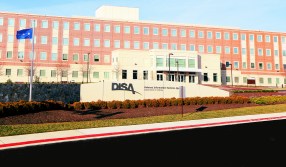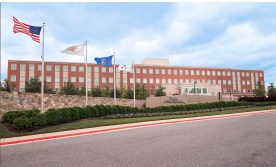DISA to make cloud and mobile enabled networks 2016 priority
The Defense Information Systems Agency has begun taking concrete steps toward rolling out cloud and mobile enabled network technologies to improve IT performance and security across the Department of Defense, a Pentagon official said Tuesday.
David Bennett, who heads DISA’s implementation and sustainment center, said that the agency is mapping out plans to move its cybersecurity boundaries, from localized bases to regional hubs, “So there are fewer points in the ecosystem that we have to protect.” he said, speaking at FedScoop’s FedTalks government innovation forum Tuesday.
He also said DISA has successfully developed smartphones that can operate on DOD’s Secret Internet Protocol Router Network, capable of transmitting classified information up to the “secret” level.
“Taking a commercial solution and bringing that into these environments in a no-fail [situation] is a pretty big step forward,” Bennett said. The secure smartphones look no different than everyday smartphones, he said, and are a far cry from the brick-like, and much-derided SME-PED smartphones DOD developed in 2009.
“Everyone knows DOD is slow,” Bennett said. “Our world is not about making money, it’s about fighting the nation’s battle where most folks in this room do not go, where it’s not hospitable to IT.”
Advances in cloud technologies and virtualization, however, are also giving DISA new ways to provide more flexibility to military operations while trying to protect defense networks, too. Bennett, for instance, said DISA is moving to secure endpoints by pushing out images instead of data using virtual desktop infrastructure, or VDI.
“VDI is a huge capability,” Bennett said. “I can’t get it into the field fast enough. Now I give the user the environment to move with or across the environment.”
Bennett acknowledged that the despite Defense Department’s push for Joint Regional Security Stacks, and broader joint enterprise IT systems, the agency faces an uphill climb re-educating defense IT units on the steps necessary to move some of their IT operations and applications to a cloud-based ecosystem. Some of that re-education is also necessary within DISA, he said.
With 12,000 employees who are scattered across the globe and 15,000 locations that support military personnel and operations, Bennett acknowledged that “we need to change the agency” to innovate.
“Folks say, ‘I’m used to doing this process in 10 steps and that’s the way I’ve done it for 10 years,’” he said. “It isn’t just the technical change, it’s ‘how do I best put capabilities in place that optimize how we do business going forward?’ And do it in a way that’s easy to work with the user community to help them understand this new solution.”
Wyatt Kash contributed to this report.
Read the rest of our 2015 FedTalks coverage:
Tony Scott: Cybersecurity means sharing more than just information
Blackberry taking ‘balanced’ approach to encryption, lawful intercept
Pentagon IT leaders push for more collaboration across defense agencies
IT leaders discuss cybersecurity, innovation at 2015 FedTalks
Watch our TV coverage of FedTalks 2015:
Social Security’s Herb Strauss on meeting citizens’ demands
DOT CIO Richard McKinney on his ‘sense of urgency’ with FITARA
CIO John Owens discusses DevOps at USPTO
EPA’s Ann Dunkin on her love for FITARA






